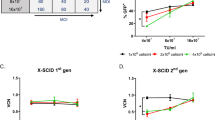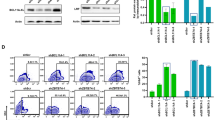Abstract
We have proposed a novel concept, ie selective expansion of transduced cells, to overcome the low efficiency of gene transfer into hematopoietic stem cells. Previously, a fusion gene encoding a chimeric receptor (ΔGCRER) between the mouse granulocyte colony-stimulating factor receptor (G-CSFR) and the hormone-binding domain of rat estrogen receptor was constructed as a ‘selective amplifier gene’. Although the chimeric gene conferred estrogen-inducible proliferation on the transduced Ba/F3 cells, it also mediated differentiation of the retrovirally transduced 32D cells upon estrogen treatment. Since only a growth signal is required for our purpose, we further modified the ΔGCRER gene to attenuate its differentiation signal. Based on the observation that tyrosine-703 in wild-type G-CSFR plays a pivotal role in transmitting the differentiation signal, phenylalanine was substituted for this residue in ΔGCRER. When the resultant selective amplifier gene (ΔY703F-GCRER gene) was expressed in 32D cells, sustained growth was supported by estrogen, while differentiation was suppressed. These cells ceased to grow upon estrogen withdrawal and differentiated with G-CSF treatment. The present findings suggested that ΔY703F-GCRER may have desirable properties as a selective amplifier for hematopoietic stem cell expansion and gene therapy.
This is a preview of subscription content, access via your institution
Access options
Subscribe to this journal
Receive 12 print issues and online access
$259.00 per year
only $21.58 per issue
Buy this article
- Purchase on Springer Link
- Instant access to full article PDF
Prices may be subject to local taxes which are calculated during checkout





Similar content being viewed by others
References
Karlsson S . Treatment of genetic defects in hematopoietic cell function by gene transfer Blood 1991 78: 2481–2492
Dunbar CE, Emmons RVB . Gene transfer into hematopoietic progenitor and stem cells: progress and problems Stem Cells 1994 12: 563–576
Havenga M, Hoogerbrugge P, Valerio D, Van Es HHG . Retroviral stem cell gene therapy Stem Cells 1997 15: 162–179
Kohn DB et al. T lymphocytes with a normal ADA gene accumulate after transplantation of transduced autologous umbilical cord blood CD34+ cells in ADA-deficient SCID neonates Nature Med 1998 4: 775–780
Ito K et al. Development of a novel selective amplifier gene for controllable expansion of transduced hematopoietic cells Blood 1997 90: 3884–3892
Avalos BR . Molecular analysis of the granulocyte colony-stimulating factor receptor Blood 1996 88: 761–777
Parker MG et al. Structure and function of the estrogen receptor Ann NY Acad Sci 1993 684: 119–126
Mattioni T, Louvion J-F, Picard D . Regulation of protein activities by fusion to steroid binding domains Meth Cell Biol 1994 43: 335–352
Fukunaga R et al. Functional domains of the granulocyte colony-stimulating factor receptor EMBO J 1991 10: 2855–2865
Dong F et al. Distinct cytoplasmic regions of the human granulocyte colony-stimulating factor receptor involved in induction of proliferation and maturation Mol Cell Biol 1993 13: 7774–7781
Fukunaga R, Ishizaka-Ikeda E, Nagata S . Growth and differentiation signals mediated by different regions in the cytoplasmic domain of granulocyte colony-stimulating factor receptor Cell 1993 74: 1079–1087
Yoshikawa A, Murakami H, Nagata S . Distinct signal transduction through the tyrosine-containing domains of the granulocyte colony-stimulating factor receptor EMBO J 1995 14: 5288–5296
Fukunaga R, Ishizaka-Ikeda E, Seto Y, Nagata S . Expression cloning of a receptor for murine granulocyte colony-stimulating factor Cell 1990 61: 341–350
Koike S, Sakai M, Muramatsu M . Molecular cloning and characterization of rat estrogen receptor cDNA Nucleic Acids Res 1987 15: 2499–2513
Onishi M et al. Applications of retrovirus-mediated expression cloning Exp Hematol 1996 24: 324–329
Duke GM, Hoffman MA, Palmenberg AC . Sequence and structural elements that contribute to efficient encephalomyocarditis virus RNA translation J Virol 1992 66: 1602–1609
Nakauchi H et al. Molecular cloning of Lyt-2, a membrane glycoprotein marking a subset of mouse T lymphocytes: molecular homology to its human counterpart, Leu-2/T8, and to immunoglobulin variable regions Proc Natl Acad Sci USA 1985 82: 5126–5130
Valtieri M et al. Cytokine-dependent granulocytic differentiation: regulation of proliferative and differentiative responses in a murine progenitor cell line J Immunol 1987 138: 3829–3835
Albritton LM, Tseng L, Scadden D, Cunningham JM . A putative murine ecotropic retrovirus receptor gene encodes a multiple membrane-spanning protein and confers susceptibility to virus infection Cell 1989 57: 659–666
Scudiero DA et al. Evaluation of a soluble tetrazolium/formazan assay for cell growth and drug sensitivity in culture using human and other tumor cell lines Cancer Res 1988 48: 4827–4833
De Koning JP et al. Proliferation signaling and activation of Shc, p21Ras, and Myc via tyrosine 764 of human granulocyte colony-stimulating factor receptor Blood 1998 91: 1924–1933
Sorrentino BP et al. Selection of drug-resistant bone marrow cells in vivo after retroviral transfer of human MDR1 Science 1992 257: 99–103
Blau CA, Peterson KR, Drachman JG, Spencer DM . A proliferation switch for genetically modified cells Proc Natl Acad Sci USA 1997 94: 3076–3081
Jin L, Asano H, Blau CA . Stimulating cell proliferation through the pharmacologic activation of c-kit Blood 1998 91: 890–897
Kodaira H et al. Fas and mutant estrogen receptor chimeric gene: a novel suicide vector for tamoxifen-inducible apoptosis Jpn J Cancer Res 1998 89: 741–747
Gorman CM et al. The Rous sarcoma virus long terminal repeat is a strong promoter when introduced into a variety of eukaryotic cells by DNA-mediated transfection Proc Natl Acad Sci USA 1982 79: 6777–6781
Fung MC et al. Molecular cloning of cDNA for murine interleukin-3 Nature 1984 307: 233–237
Blochlinger K, Diggelmann H . Hygromycin B phosphotransferase as a selectable marker for DNA transfer experiments with higher eukaryotic cells Mol Cell Biol 1984 4: 2929–2931
Karasuyama H, Melchers F . Establishment of mouse cell lines which constitutively secrete large quantities of interleukin 2, 3, 4 or 5, using modified cDNA expression vectors Eur J Immunol 1988 18: 97–104
Gorman C, Padmanbhan R, Howard BH . High efficiency DNA-mediated transformation of primate cells Science 1983 221: 551–553
Acknowledgements
We thank Dr JM Cunningham, Dr T Suda and Chugai Pharmaceuticals for research materials, and Dr A Okano for IL-3 titration. This work was supported in part by grants from the Ministry of Health and Welfare of Japan and Grants-in-Aid for Scientific Research from the Ministry of Education, Science, Sports and Culture of Japan.
Author information
Authors and Affiliations
Rights and permissions
About this article
Cite this article
Matsuda, K., Kume, A., Ueda, Y. et al. Development of a modified selective amplifier gene for hematopoietic stem cell gene therapy. Gene Ther 6, 1038–1044 (1999). https://doi.org/10.1038/sj.gt.3300906
Received:
Accepted:
Published:
Issue Date:
DOI: https://doi.org/10.1038/sj.gt.3300906
Keywords
This article is cited by
-
Expansion of genetically corrected neutrophils in chronic granulomatous disease mice by cotransferring a therapeutic gene and a selective amplifier gene
Gene Therapy (2004)
-
In vivo selective expansion of gene-modified hematopoietic cells in a nonhuman primate model
Gene Therapy (2002)
-
Hematopoietic Stem Cell Gene Therapy
International Journal of Hematology (2002)
-
Selective Expansion of Transduced Cells for Hematopoietic Stem Cell Gene Therapy
International Journal of Hematology (2002)
-
Clinical Gene Therapy in Hematology: Past and Future
International Journal of Hematology (2001)



